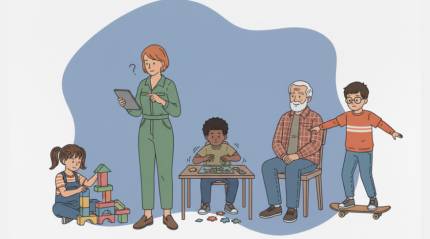Ultimate Guide to ADHD Quizzes for Kids: Purpose, Process, and Practical Benefits
- 17 October 2025

What Is an ADHD Quiz for Kids?
Families and educators often look for clear, compassionate ways to understand a child’s attention, activity level, and self-regulation. An ADHD screening quiz is a short series of questions that maps everyday behaviors like focus during homework, impulse control in play, and follow-through on tasks onto well-researched patterns. These tools do not diagnose, and they never replace a licensed clinician’s evaluation. Instead, they help adults notice trends, start informed conversations, and decide whether to seek professional guidance. With straightforward wording and age-appropriate examples, good screeners are approachable, quick to complete, and easy to review together.
Parents sometimes feel overwhelmed by mixed messages from school notes, report cards, or shifting routines at home. Many find that a lightweight questionnaire clarifies which behaviors are occasional friction points versus consistent challenges across environments. In that spirit, families may try the ADHD quiz for kids as a low-pressure way to organize observations and highlight patterns worth discussing with a pediatrician, counselor, or school team. Results can prompt supportive steps like adjusting study spaces, teaching step-by-step routines, or requesting classroom accommodations while avoiding labels or assumptions. The goal is confidence, not conclusions, and a path that respects the child’s strengths as much as their needs.
- Sets a common language for teachers, caregivers, and clinicians.
- Surfaces behavior patterns across home, school, and activities.
- Encourages early, strength-based support rather than wait-and-see.
- Helps track changes over time after interventions or routine shifts.
How Screening Quizzes Work and What They Measure
Most reputable screening tools borrow elements from validated rating scales and present them in family-friendly language. Items typically ask how often a behavior occurs, such as forgetting instructions, fidgeting during seated tasks, or blurting out answers. Scores are then grouped into domains like inattention, hyperactivity, and impulsivity, which mirror clinical frameworks while remaining accessible. Because context matters, strong tools encourage input from multiple observers parent, teacher, coach since a child may thrive on the playground but struggle during quiet reading, or vice versa. Patterns across settings are more informative than isolated moments.
Digital versions add conveniences like autosave, progress indicators, and summaries that can be printed or shared. When time is limited, a short form can provide a snapshot, while longer versions capture nuance. Caregivers juggling busy evenings sometimes prefer a mobile-friendly format that fits into real life without adding friction. For those families, the ADHD online quiz kids offers quick access, straightforward scoring, and a gentle on-ramp to deeper support if needed. Regardless of format, the most useful tools are transparent about what they measure, how scores are interpreted, and where to go next if concerns persist beyond everyday variability.
- Inattention items: sustaining focus, organizing materials, following multi-step directions.
- Hyperactivity items: restlessness, difficulty remaining seated, frequent movement.
- Impulsivity items: interrupting, impatience, risk-taking without forethought.
- Functioning items: homework completion, peer relationships, emotional regulation.
Benefits, Pitfalls, and Ethical Use
Screening quizzes shine when they prompt reflection, coordination, and practical adjustments. A parent might realize that morning routines are the true bottleneck, prompting a visual checklist on the fridge. A teacher might notice that independent work periods are tougher than group projects, suggesting new seating or timed breaks. When multiple adults compare notes, an emerging picture guides next steps that feel humane and realistic. Over time, repeated screenings can show whether changes like a new bedtime, a planner system, or therapy are easing friction at home and school.
It’s equally important to avoid common pitfalls. No single score should define a child’s identity, and cultural or language factors can influence how questions land. Busy weeks, illness, or life transitions may skew responses, which is why trends over time are more meaningful than one-off results. Teachers can add crucial classroom context, and pediatric clinicians can screen for sleep, vision, anxiety, or learning differences that mimic similar behaviors. Educators often respond thoughtfully when families share insights from an ADHD quiz children, because collaboration fosters individualized strategies that celebrate strengths while supporting growth. Ethical use centers the child, honors diversity, and seeks qualified guidance when uncertainty remains.
- Avoid labeling; focus on observable behaviors and specific supports.
- Repeat screenings after changes to track progress and fine-tune plans.
- Invite multiple observers to reduce bias and broaden perspective.
- Consult licensed professionals for assessment beyond initial screening.
Formats, Time, and Use Cases at a Glance
Choosing a quiz format depends on age, reading level, and your goals. Short forms are ideal for a quick check before a parent–teacher conference, while comprehensive versions fit best when you plan to consult a clinician. Some tools emphasize everyday routines morning transitions, homework stations, music lessons while others lean on standardized behaviors aligned with research frameworks. If possible, try both a brief and a longer version across a few weeks to see whether responses are stable or sensitive to context, sleep, or schedule shifts.
Many caregivers want practical clarity before setting appointments or requesting school meetings. For those families, a conversational screener can reduce uncertainty and prompt realistic next steps. Some parents gravitate toward a does my child have ADHD quiz to organize concerns, collect examples, and bring a concise snapshot to a pediatric visit. The table below contrasts typical formats, time commitments, and best-fit scenarios to help you pick the right starting point.
| Format | Estimated Time | Best For |
|---|---|---|
| Short Form (10–15 items) | 5–7 minutes | Quick check before school or doctor conversations |
| Standard Form (20–30 items) | 10–15 minutes | Balanced overview across home and classroom settings |
| Comprehensive Form (40+ items) | 20–30 minutes | Deeper dive before clinical consultation |
| Multi-Observer Bundle | Varies by contributors | Comparing parent, teacher, and coach perspectives |
Regardless of format, clarity improves when you choose consistent windows for observation, like two ordinary school weeks without unusual stressors. If you can, review results with someone who sees the child in a different context to balance impressions. Small environmental adjustments structured routines, movement breaks, clear instructions often make an immediate difference while you consider whether to pursue a formal evaluation. The right fit is the tool that gives you actionable insight with minimal stress.
Interpreting Results and Next Steps for Families
After completing a screener, start with the big picture: Which situations are smooth, and which are bumpy? It helps to write down two or three concrete examples for each challenging behavior so you can describe patterns without judgment. Then consider low-lift supports like timers, visual schedules, or quiet study nooks that can reduce friction quickly. If concerns persist across settings and weeks, bring results and examples to your pediatrician or school support team to discuss a formal evaluation or targeted interventions.
Age matters when picking strategies and interpreting wording, because developmental milestones shape expectations. Older elementary students often respond well to collaborative planning and self-monitoring tools that build independence. In that spirit, families sometimes choose an ADHD quiz for 12 year olds to ensure questions match the student’s responsibilities, such as long-term projects, changing classes, or extracurricular commitments. When a child participates in reviewing results, they gain agency, and small wins like packing a backpack the night before compound into meaningful progress. Keep notes, celebrate strengths, and revisit plans regularly to keep momentum strong.
- Summarize two wins and two challenges each week to track trends.
- Pair supports with strengths, like using movement breaks after focused reading.
- Share a concise results summary with teachers to align strategies.
- Schedule follow-ups to adjust tools as routines and demands evolve.
Faq: Common Questions About Kids’ ADHD Quizzes
Are online ADHD quizzes accurate enough to trust?
They are screening tools, not diagnostic instruments, but well-designed quizzes can spotlight patterns worth exploring with a clinician. Accuracy improves when multiple adults contribute observations and when you use ordinary weeks rather than unusual or stressful periods. Use results to guide conversations, not as definitive answers.
How should I prepare before taking a quiz with my child in mind?
Gather concrete examples from the past two weeks across home, school, and activities. Ask a teacher or caregiver for input, and note sleep, routines, or health changes that might influence behavior. Clear, recent observations produce more dependable results and more useful next steps.
What should I do if scores look elevated in several areas?
Consider making immediate, low-stress adjustments structured routines, visual checklists, and brief movement breaks to reduce friction. Then share the results and examples with your pediatrician or school support team to discuss whether a comprehensive evaluation is appropriate. Early collaboration often leads to quicker relief.
Can high energy or daydreaming alone indicate ADHD?
High activity or frequent daydreaming can be developmentally typical, and context is key. Persistent challenges across settings, significant functional impacts, and patterns over time are more informative than one trait in isolation. A clinician can help differentiate overlapping possibilities like sleep issues or learning differences.
How often should we retake a screening quiz?
Retesting every six to eight weeks can show whether changes like new routines, coaching, or therapy are helping. If circumstances shift dramatically, such as a new school year or schedule, another check can recalibrate supports. Keep summaries to compare progress and refine plans collaboratively.



